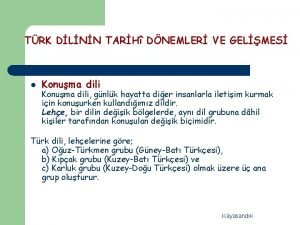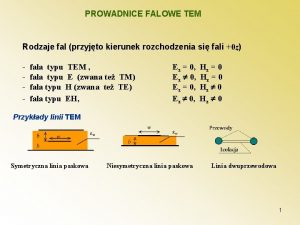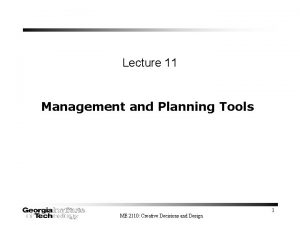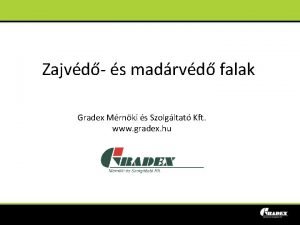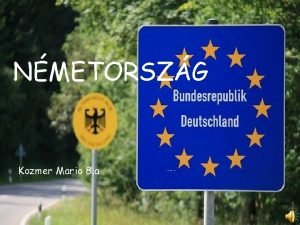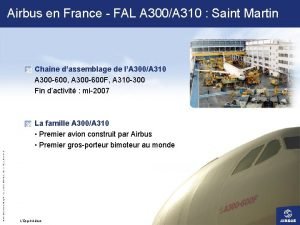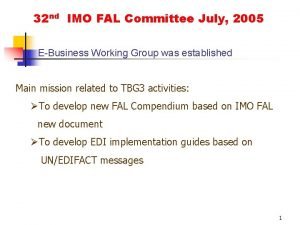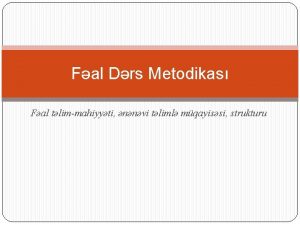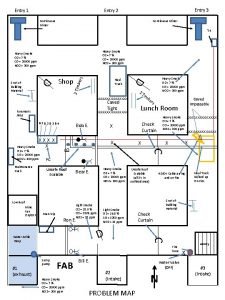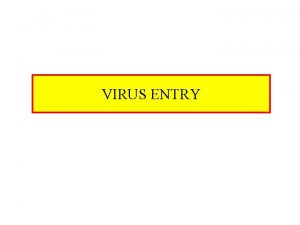FAL Convention Adopted 9 th April 1965 Entry










- Slides: 10

FAL Convention Adopted 9 th April 1965 Entry into force 5 th March 1967 Dinesh Gautama

Problems on Entry into Port • As shipping and trade developed and grew in the early part of the twentieth century, so did the paperwork involved. By the 1950 s it was being regarded not simply as an inconvenience but as a threat. • Actual number of documents increased though information required was same • Format and number of copies changed from port to port • Local languages, official translations, visa requirements • Variations in document size and paper stock • Excessive documentation

Need for Facilitation • By the early 1960 s the maritime nations had decided that the situation could not be allowed to deteriorate further. International action was called for and to achieve it Governments turned to IMO, which had held its first meeting in 1959. In 1961 the 2 nd IMO Assembly adopted resolution A. 29 (II) which recommended that IMO take up the matter. An Expert Group was convened which recommended that an international convention be adopted to assist the facilitation of international maritime traffic.

Adoption of FAL Convention • In October 1963 the 3 rd IMO Assembly adopted resolution A. 63 (III) which approved the report of Expert Group and in particular recommended that a convention be drafted which would be considered for adoption at a conference to be held under IMO auspices in the spring of 1965. The conference duly took place and the Convention on Facilitation of International Maritime Traffic (FAL), 1965 was adopted on 9 April.

FAL convention objectives • The Convention's main objectives are to prevent unnecessary delays in maritime traffic, to aid co -operation between Governments, and to secure the highest practicable degree of uniformity in formalities and other procedures. In particular, the Convention reduces to just eight the number of declarations which can be required by public authorities.

Standards and recommended practices • In its Annex, the Convention contains "Standards" and "Recommended Practices" on formalities, documentary requirements and procedures which should be applied on arrival, stay and departure to the ship itself, and to its crew, passengers, baggage and cargo

Definitions • “Standards” are internationally-agreed measures which are "necessary and practicable in order to facilitate international maritime traffic" • “Recommended practices” are measures the application of which is "desirable".

FAL Recommendations • The Convention provides that any Contracting Government which finds it impracticable to comply with any international standard, or deems it necessary to adopt differing regulations, must inform the Secretary. General of IMO of the "differences" between its own practices and the standards in question. The same procedure applies to new or amended standards. In the case of recommended practices, Contracting Governments are urged to adjust their laws accordingly but are only required to notify the Secretary-General when they have brought their own formalities, documentary requirements and procedures into full accord. This flexible concept of standards and recommended practices, coupled with the other provisions, allows continuing progress to be made towards the formulation and adoption of uniform measures in the facilitation of international maritime traffic.

The IMO Standardized Forms (FAL 1 -7) • • IMO General Declaration Cargo Declaration Ship's Stores Declaration Crew's Effects Declaration Crew List· Passenger List Dangerous Goods Form under Universal Postal Union (UPU) Form under International Health Regulations

Thank you

